

Words and Deeds of Charles Rufus Morey at the American Embassy in Rome (1945-1950)
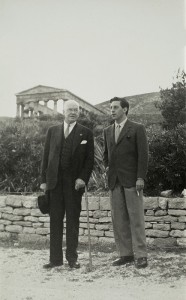
Charles Rufus Morey, founder of the Index of Christian Art, was the first to fulfill the role of American cultural attaché to Italy, a tenure beginning with his retirement from Princeton University’s Department of Art and Archaeology in 1945. A champion of Italian culture, Morey’s mission at the American Embassy in Rome not only promoted Italian national heritage but reconstructed it after the ravages of world war. Morey’s distinguished background in classics and art history, coupled with his longstanding ties to the study of historical Rome, made his assignment all the more fitting.
As a diplomat, Morey actively sought opportunities to repatriate books and works of art looted in wartime Europe and he created the Union of Archaeological and Historical Institutes to safeguard artifacts in transit. Two of his notable publications while in Rome were, “The War and Medieval Art,” College Art Journal, IV, 1945, and “Saving Europe’s Art,” Journal of the American Institute of Architects, III, 1945. Among his main activities were the establishment and maintenance of research libraries in Italy. Morey oversaw the direction of the American Academy in Rome from 1945 to 1947, where he brought in major speakers, lectured widely, and organized exhibitions which increased Italian–American cultural exchange. He formed many collegial relationships with important people, among them nobles, curators, and clerics, who knew him as Professore. Pictured here from the Index archive is a photographic postcard dated 1948 of Morey with Prince Don Giovanni Francesco Alliata di Montereale, President of the Nato-American Association, while they walk together in Segesta, Sicily.
The Index is fortunate to house a wealth of materials associated with Morey during his time in the Foreign Service. Through these items, we wish to show a different facet of the founder of the Index, whose words and deeds as a cultural attaché to Italy left a lasting mark on this organization. On long-term display in the Index is a collection of Morey’s prize medals given to him on various occasions, including one from Pope Pius XII to commemorate the Jubilee year in 1950.
This exhibition was planned to accompany the 25-26 March 2016 Symposium of the Research Group on Manuscript Evidence, “Words and Deeds: Actions Enacted, Re-Enacted & Restored.” These materials will be on view until 31 May 2016.
“And when he was come into Jerusalem, the whole city was moved, saying: Who is this? And the people said: This is Jesus the prophet, from Nazareth of Galilee.” (Matthew 21:10-11)
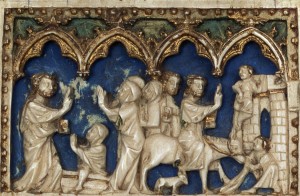
Celebrated seven days before Easter Sunday, Palm Sunday marks the beginning of Passion Week and commemorates Jesus’s triumphal entry into Jerusalem. The episode, which appears in the four canonical gospels, describes the multitudes gathering at the gates of Jerusalem to welcome Jesus, laying their cloaks and branches on the ground in recognition of his status as the Messiah.
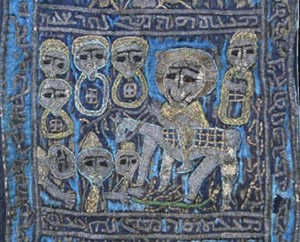
The earliest extant pictorial representations of the Entry into Jerusalem date to the fourth century, and the subject was popular across media throughout the Middle Ages. A highly compressed version of the episode appears on a fourteenth-century ivory diptych from the Abbey of Muri, Switzerland, which is decorated with Passion scenes. The right side of one of the leaves portrays a single disciple trailing the mounted Christ blessing two figures, who serve as shorthand for the multitudes. Equally schematic is the Entry into Jerusalem on the batrashil of bishop Athanasius Abraham Yaghmur of Nebek, produced in Syria in the fourteenth century. This long, embroidered stole shows three figures placing a palm branch before Christ, riding on an ass and attended by five disciples.
The lintel from the main portal of the twelfth-century church of San Leonardo al Frigido in Italy presents a more expansive version of the scene by illustrating all twelve disciples, their open mouths perhaps indicative of speech, and three small figures perched in a tree on the right-hand side of the composition. The last detail, common in depictions of the subject, relates to the prophecy of Zechariah, which describes children breaking branches from an olive tree and following the crowd into Jerusalem.
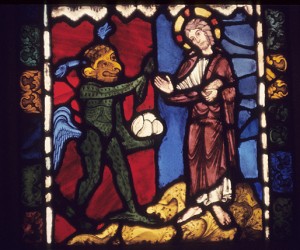
The model during Lent, the forty days of reflection and restraint before Easter, is Christ in the desert overcoming temptation. According to the Gospel writers Matthew, Mark, and Luke, Christ wandered alone in the Judean desert for forty days immediately following his baptism and before starting his public ministry. Satan first tempted Christ in the desert to turn stones into bread. Christ responded by quoting Deuteronomy 8:3, “It is written, man shall not live by bread alone…”. The Gospels describe two other attempts of temptation to win over both Christ’s pride and power. On the second temptation and with a dramatic setting change, Satan tested Christ to act independently from God and use his divine powers to jump from the height of the temple in Jerusalem – Christ firmly refused. Finally, Satan made a grand offer to Christ; to bask in the glory of all the kingdoms of the world if he would give up his mission and be partners with Satan, to which Christ replied, “Get thee hence.”
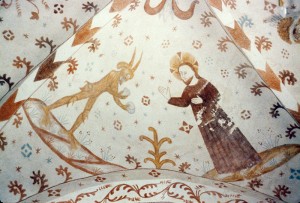
By the time of Gregory the Great, Pope from 590-604 CE, medieval Christians were expected to observe Lent by emulating these desert trials of Christ by fasting from animal products, remaining diligent in prayer, and giving alms to the poor. Typically, one meal per day was consumed during Lent; save the worship day of Sunday, observers were to resist all carnal attractions. The strict prohibitions during Lent required endurance from believers and tested their own degree of devotion.
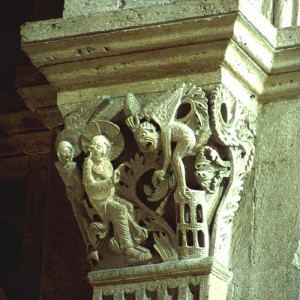
The Index classifies the Temptation episodes in three major divisions according to the number of times the devil tried to seduce Christ. Currently, the database records the most scenes for “Christ: Temptation, 1st,” the temptation for hunger, and works of art are mostly executed in manuscript illumination, but also stained glass, fresco, and sculpture, as shown. There is also a general subject category for “Christ: Temptation” which is used to describe scenes where Christ and Satan are facing each other in an unknown part of the narrative or when all three Temptations are depicted in one scene as in the south vault mosaic at San Marco in Venice . “Christ: in Wilderness” is often a subsequent subject heading applied to the Temptation scenes as well as, “Christ: ministered to by Angels.” The latter records a specific part in the narrative when Christ is kept alive in the desert by angels following the departure of the devil. Lent, coming from the Old English word “lengthening,” is the transitional time in the church calendar and for the seasons.
This year, the vernal equinox in the northern hemisphere falls on Sunday, March 20, marking the moment when the sun shines directly on the equator and the length of day and night are nearly equal. In anticipation of the change of season, The Index of Christian Art presents images thematically related to spring. First, a fifth-century mosaic from the synagogue in Zippori, an abandoned Roman-era town in central Galilee, depicts a personification of spring, identified by Greek and Hebrew inscriptions. Portrayed with roses in her hair, the bust-length figure is flanked by a blossoming branch and a bowl of flowers (on the left) and a basket of flowers and two lilies (on the right).
Second, a personification of March, labelled MARCIUS, graces a Catalonian textile from the late-eleventh or early-twelfth century. The figure appears to be chasing a stork (CICONIA), known as a harbinger of spring because of its migratory patterns. The figure holds a serpent, described in medieval bestiaries as an enemy of the stork, and a frog, perhaps a reference to the rainy season. Above is a personification of the north wind (FRIGUS), as well as a crescent moon and blazing sun. Last, a thirteenth-century Flemish Psalter depicts a figure pruning a stylized tree, an agricultural labor closely associated with the month of March.